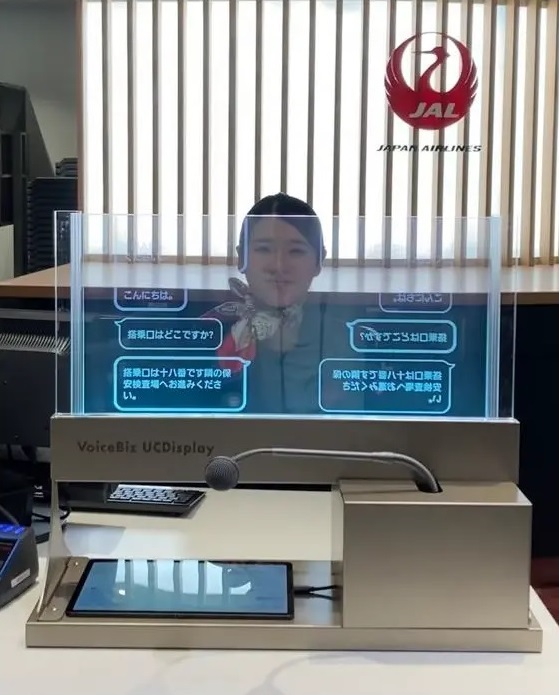
”Please tell me your smartphone.”
This week, Japan Airlines and Tokyo-based tech firm Toppan began demonstrating a new system designed to help foreign travelers on their way into or out of Japan. Beginning with Tokyo’s Haneda Airport, JAL will be using Toppan’s VoiceBiz UCDisplay panel to provide what it hopes will be smooth, stress-free communication between JAL staff who speak Japanese and travelers who don’t.
The transparent color displays provide text translations based on either keyboard or voice inputs. The screen displays both the original and translated version of the message to make it easy for both parties to follow along, and the see-through design of the panel also lets JAL staff and travelers communicate face-to-face, providing a more personal touch than some other translation formats. JAL began using the system on July 2 at Haneda, where the trial will run until July 8, and next month it’ll be in operation at Osaka’s Itami from August 20 to 26.
Considering that travelers are often tired and pressed for time at the airport, it makes sense for JAL to be interested in anything to help bridge the additional difficulties of a language barrier. However, it looks like the system isn’t exactly perfect, as a photo of the system in action has already shown it stumbling over how to intelligently render a request in English.
羽田空港カウンターに翻訳ディスプレー、JALとTOPPANが実験…英語や中国語など13言語https://t.co/xp48GSdpxz#経済
— 読売新聞オンライン (@Yomiuri_Online) July 2, 2024
Zoom in, and you’ll see three sentences on the screen in the above photo. The first, translated as “I have a smartphone,” is fine. The third sentence is a little bumpier, saying “You are Ms. Hanako Ozora on flight number nine hundred nineteen to Okinawa at fourteen forty five,” but it’s not too bad. Sure, something like “I see that you’re Ms. Hanako Ozora” would feel more natural, as would rendering the departure time in numerals, or maybe converting it to a 12-hour-clock format. Still, it’s understandable.
The problem, though, comes with the second sentence, which the system has rendered in English as:
“Please tell me your smart phone.”
This one doesn’t make any sense, and there’s a good chance that if you told someone “Please tell me your smart phone,” they’d have no idea what you wanted them to do.
Sometimes when Japanese-to-English translation hiccups happen in Japan, it’s possible to work backwards and diagnose what the speaker was actually trying to say, using a basic understanding of fundamental differences between the two language’s vocabulary and grammar. Oftentimes the problem stems from the propensity in Japanese to condense or omit words if the message can still be understood from context. For example, when asking someone for their contact information on popular messaging app Line, it’s most common to just say “Line wo oshiete,” literally “Tell me [your] Line,” and omit any mention of “contact info,” “profile,” “username,” etc. However, “Tell me your smart phone” isn’t a common way for asking for someone’s phone number in Japan, nor is “Tell me your phone.” Even in Japanese, the standard phrase is “Tell me your phone number.”
So if “Please tell me your smartphone” isn’t the JAL attendant asking the traveler to provide their phone number, what is it asking for? Flipping the photo around and looking at the display’s Japanese-language version of the sentence, unfortunately, doesn’t definitively solve the mystery, as the Japanese text is less than immediately intelligible too, though we’ll have to wade a bit into the linguistic reeds to explain why.
▼ Yes, of course the Japanese linguistic reeds have a samurai lurking in them.
We’ve got to zoom in pretty close to see the Japanese text, but it appears to say “スマートフォンをこちらにお●ください,” with the character between お and く being illegibly blurry. The first part, スマートフォンをこちらに (sumaatofon wo kochira ni), translates to “your smartphone here,” and ください (kudasai is “please”). お is an honorific marker used in polite speech to make humble requests, and is commonly used when a customer service worker is asking someone to do something.
String all those together, and we’ve got “Please ● your smartphone here,” so ● has to be some sort of verb/action, but the on-screen English translation’s “tell” doesn’t mesh with the location-denoting “here” of the Japanese version. There’s another problem too, which is that when using お to make requests, the necessary following conjugation of the verb generally requires at least two characters to write, not a single character like shown on the display.
▼ So long, Linguistic Reeds Samurai! We’ll see you the next time we wade all the way out here!
So it looks like both “Please tell me your smartphone” and its on-screen Japanese equivalent are both confusing. That suggests this might not only be a translation error, but an input one too, which raises the question of whether the system was attempting to translate from English to Japanese or from Japanese to English. It’s a safe bet that it’s the latter, since it’s much more likely that airline staff will need to confirm a traveler’s identity or access their account via their phone number than it is that a traveler would be asking the JAL staff for info regarding her personal phone.
As mentioned above, VoiceBiz UCDisplay can work with both keyboard and voice inputs, so the problem could be something as simple as an errant keystroke triggering a typo that the system then forced an imperfect translation of, which you could say is a case of user error. It could also be, though, that the system’s voice sensors incorrectly transcribed something the attendant said. That would be a bigger issue, since you’d hope that a system developed and being used in Japan would be at its most accurate when transcribing Japanese.
It’s especially concerning that a problem has cropped up so soon into the demonstration, when ostensibly it’s getting pitched easy topics to translate, and also that the above photo doesn’t indicate that anyone involved in the demonstration caught or corrected the error. Yes, it’s always nice to see travel providers doing what they can to make international travel easier, even for those who don’t speak the language of the country they’re visiting. At the same time, with Haneda and Itami being two of Japan’s largest entry points for international tourists, staffing qualified multilingual ground staff for frontline customer interaction positions doesn’t seem like it should be outside the realm of suitable expenditures for JAL, one of Japan’s largest airlines.
It’s worth reiterating that the system is currently only in a trial state, and it’s only being used at the special assistance counters in Haneda’s Terminal 1 South Wing and Itami’s North Terminal, plus a few other places in the facilities, so it’s not like the translation panels are the only option for communicating with JAL staff. Still, this is all a reminder that there’s really no substitute for a human being who knows what they’re talking about.
Source: PR Times
Top image: PR Times
Insert images: Pakutaso (1, 2)
● Want to hear about SoraNews24’s latest articles as soon as they’re published? Follow us on Facebook and Twitter!




 JAL system makes air travel easier and lets you keep laptops, liquids in bag for security check
JAL system makes air travel easier and lets you keep laptops, liquids in bag for security check Japan Airlines giving foreign travelers 100,000 free round-trip tickets during the Tokyo Olympics
Japan Airlines giving foreign travelers 100,000 free round-trip tickets during the Tokyo Olympics Kyoto study finds nearly 500 translation errors for foreign tourists, new guidelines released
Kyoto study finds nearly 500 translation errors for foreign tourists, new guidelines released Gundam Jet takes flight in Japan, comes with opportunities for Japan Airline-exclusive Gunpla
Gundam Jet takes flight in Japan, comes with opportunities for Japan Airline-exclusive Gunpla Haneda Airport getting rid of large flight information monitors at security lines in Terminal 2
Haneda Airport getting rid of large flight information monitors at security lines in Terminal 2 Majority of Japanese mayors say foreign residents are essential but most see good and bad effects
Majority of Japanese mayors say foreign residents are essential but most see good and bad effects Japanese beef bowl chain Sukiya’s 2026 Smile Box lucky bag basically pays for itself
Japanese beef bowl chain Sukiya’s 2026 Smile Box lucky bag basically pays for itself Dedicate your savings to your oshi of choice with this new buildable offertory box
Dedicate your savings to your oshi of choice with this new buildable offertory box Survey asks Japanese teens which school club they want to join, and “kitaku” club is top choice
Survey asks Japanese teens which school club they want to join, and “kitaku” club is top choice Japanese toilet sweets put a new twist on tradition
Japanese toilet sweets put a new twist on tradition New Studio Ghibli collection includes a US$2,450 wooden Totoro 【Video】
New Studio Ghibli collection includes a US$2,450 wooden Totoro 【Video】 Pizza Hut Japan’s hot lucky bags are perfect for a New Year’s pizza party
Pizza Hut Japan’s hot lucky bags are perfect for a New Year’s pizza party Japan’s first hotel with a human washing machine is now ready for you to come and bathe in it
Japan’s first hotel with a human washing machine is now ready for you to come and bathe in it Green tea chocolate-covered potato chips arrive in Japan! 【Taste test】
Green tea chocolate-covered potato chips arrive in Japan! 【Taste test】 Japan now has potato chip-covered chocolate, and it’s amazing!【Taste test】
Japan now has potato chip-covered chocolate, and it’s amazing!【Taste test】 Starbucks Japan ready to get Year of the Horse started with adorable drinkware and plushies【Pics】
Starbucks Japan ready to get Year of the Horse started with adorable drinkware and plushies【Pics】 Hayao Miyazaki says Happy New Year to Studio Ghibli fans with new art for Year of the Horse
Hayao Miyazaki says Happy New Year to Studio Ghibli fans with new art for Year of the Horse We found possibly the quietest Japanese-style hotel in Tokyo’s bustling Shinjuku district
We found possibly the quietest Japanese-style hotel in Tokyo’s bustling Shinjuku district Cup Noodle tries an authentic Jiro-style ramen, but something’s not quite right
Cup Noodle tries an authentic Jiro-style ramen, but something’s not quite right The best Starbucks Japan Frappuccinos we want to drink again in 2026
The best Starbucks Japan Frappuccinos we want to drink again in 2026 We revisited Sweets Paradise after a decade to see if Japan’s dessert buffet still delivers
We revisited Sweets Paradise after a decade to see if Japan’s dessert buffet still delivers That time Seiji called JASRAC to ask why he didn’t get paid royalties for his song being on TV
That time Seiji called JASRAC to ask why he didn’t get paid royalties for his song being on TV Japan’s oldest largetooth sawfish in captivity back on display in Mie Prefecture
Japan’s oldest largetooth sawfish in captivity back on display in Mie Prefecture 7-Eleven Japan starts new temporary luggage storage service in over 300 branches
7-Eleven Japan starts new temporary luggage storage service in over 300 branches Disillusionment at Tsukiji’s tourist-target prices led us to a great ramen restaurant in Tokyo
Disillusionment at Tsukiji’s tourist-target prices led us to a great ramen restaurant in Tokyo Starbucks teams up with 166-year-old Kyoto doll maker for Year of the Horse decorations【Photos】
Starbucks teams up with 166-year-old Kyoto doll maker for Year of the Horse decorations【Photos】 Tokyo considering law requiring more trash cans following litter increase in heavily touristed area
Tokyo considering law requiring more trash cans following litter increase in heavily touristed area Tokyo’s Tsukiji sushi neighborhood asks tour groups to stay away for the rest of the month
Tokyo’s Tsukiji sushi neighborhood asks tour groups to stay away for the rest of the month Tokyo event lets you travel back in time, for free, to celebrate 100 years since Showa era start
Tokyo event lets you travel back in time, for free, to celebrate 100 years since Showa era start Japan may add Japanese language proficiency, lifestyle classes to permanent foreign resident requirements
Japan may add Japanese language proficiency, lifestyle classes to permanent foreign resident requirements Sanrio theme park in Japan announces plans to expand into a Sanrio resort
Sanrio theme park in Japan announces plans to expand into a Sanrio resort Stamina-destroying “Paralysis Noodles” are Tokyo’s newest over-the-top ramen innovation
Stamina-destroying “Paralysis Noodles” are Tokyo’s newest over-the-top ramen innovation Survey asks foreign tourists what bothered them in Japan, more than half gave same answer
Survey asks foreign tourists what bothered them in Japan, more than half gave same answer Japan’s human washing machines will go on sale to general public, demos to be held in Tokyo
Japan’s human washing machines will go on sale to general public, demos to be held in Tokyo Japan’s deadliest food claims more victims, but why do people keep eating it for New Year’s?
Japan’s deadliest food claims more victims, but why do people keep eating it for New Year’s? We deeply regret going into this tunnel on our walk in the mountains of Japan
We deeply regret going into this tunnel on our walk in the mountains of Japan Studio Ghibli releases Kodama forest spirits from Princess Mononoke to light up your home
Studio Ghibli releases Kodama forest spirits from Princess Mononoke to light up your home Major Japanese hotel chain says reservations via overseas booking sites may not be valid
Major Japanese hotel chain says reservations via overseas booking sites may not be valid Put sesame oil in your coffee? Japanese maker says it’s the best way to start your day【Taste test】
Put sesame oil in your coffee? Japanese maker says it’s the best way to start your day【Taste test】 No more using real katana for tourism activities, Japan’s National Police Agency says
No more using real katana for tourism activities, Japan’s National Police Agency says Starbucks Japan reveals new sakura drinkware collection, inspired by evening cherry blossoms
Starbucks Japan reveals new sakura drinkware collection, inspired by evening cherry blossoms Updated cherry blossom forecast shows extra-long sakura season for Japan this year
Updated cherry blossom forecast shows extra-long sakura season for Japan this year Japan Airlines abolishes use of “ladies and gentlemen” in English for sake of sexual minorities
Japan Airlines abolishes use of “ladies and gentlemen” in English for sake of sexual minorities Haneda Airport mobile tea ceremony lets you start, or finish, your Japan trip with a tranquil sip
Haneda Airport mobile tea ceremony lets you start, or finish, your Japan trip with a tranquil sip Japan Airlines staff reassigned to work as shrine maidens during coronavirus travel downturn
Japan Airlines staff reassigned to work as shrine maidens during coronavirus travel downturn Japanese airlines offer discounted fares to international tourists
Japanese airlines offer discounted fares to international tourists Japanese airlines, including JAL and ANA, enacting new mobile battery carry-on rules this month
Japanese airlines, including JAL and ANA, enacting new mobile battery carry-on rules this month Eat up, take off – The 20 best airport restaurants in Japan, as chosen by travelers
Eat up, take off – The 20 best airport restaurants in Japan, as chosen by travelers Mobile battery starts emitting smoke inside airplane bound for Tokyo’s Haneda airport
Mobile battery starts emitting smoke inside airplane bound for Tokyo’s Haneda airport Japan Airlines concludes cabin attendant drank bottle of champagne during flight
Japan Airlines concludes cabin attendant drank bottle of champagne during flight Haneda Airport security inspector arrested for stealing cash from luggage
Haneda Airport security inspector arrested for stealing cash from luggage Japan Airlines re-re-releasing happi famously once worn by the Beatles
Japan Airlines re-re-releasing happi famously once worn by the Beatles Super Mario and Donkey Kong taking to the skies of Japan with special plane from JAL【Video】
Super Mario and Donkey Kong taking to the skies of Japan with special plane from JAL【Video】 Japan Airlines is giving away free domestic flights to international tourists
Japan Airlines is giving away free domestic flights to international tourists Japan Airlines flight attendant shares packing pro-tips, cool clear file trick【Video】
Japan Airlines flight attendant shares packing pro-tips, cool clear file trick【Video】 The happiest airline story ever: Man and smartphone reunited by awesome customer service
The happiest airline story ever: Man and smartphone reunited by awesome customer service Travelers entering Japan will have to install location confirmation app, Skype on smartphones
Travelers entering Japan will have to install location confirmation app, Skype on smartphones Japanese manners videos show how to be a “really cool” traveller in Japan 【Videos】
Japanese manners videos show how to be a “really cool” traveller in Japan 【Videos】
Leave a Reply